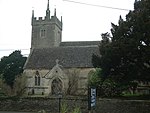Maud Heath's Causeway

Maud Heath's Causeway is a pathway dating from the 15th century in rural Wiltshire, England. On both sides of its crossing of the River Avon, just west of Kellaways, the path rises above the floodplain on sixty-four brick arches (built 1812, largely reconstructed in the 20th century) alongside an undistinguished country road between Bremhill and Langley Burrell. The causeway is the gift of the eponymous Maud Heath, who made her living carrying eggs to market at Chippenham. She was a widow and childless, and when she died she left money to improve and maintain the path along which she had tramped to market several times a week for most of her life. Over five hundred years later, the charity still maintains the path out of her bequest. Since 1960, the raised section has been listed Grade II* on the National Heritage List for England.A brief guide to the causeway was written by K.R. Clew in 1982.
Excerpt from the Wikipedia article Maud Heath's Causeway (License: CC BY-SA 3.0, Authors, Images).Maud Heath's Causeway
Maud Heath's Causeway,
Geographical coordinates (GPS) Address Nearby Places Show on map
Geographical coordinates (GPS)
| Latitude | Longitude |
|---|---|
| N 51.481 ° | E -2.0782 ° |
Address
Maud Heath's Causeway
Maud Heath's Causeway
SN15 4LP , Langley Burrell Without
England, United Kingdom
Open on Google Maps








